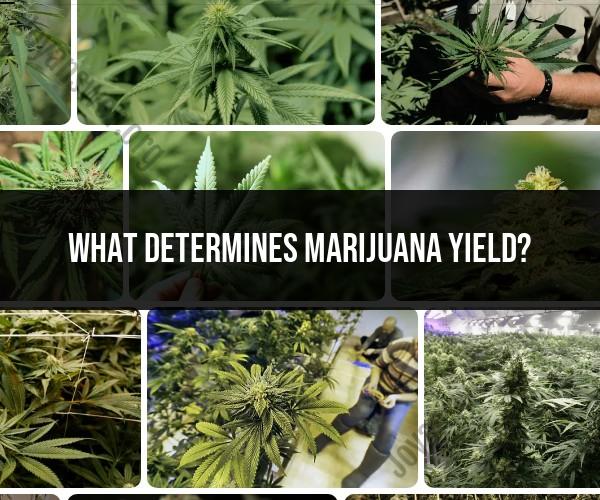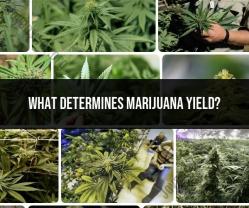Factors That Determine Marijuana Yield: A Comprehensive Guide
October 4, 2023 by JoyAnswer.org, Category : Cannabis Cultivation
What determines marijuana yield? Explore the various factors that influence marijuana yield, including genetics, cultivation methods, and environmental conditions.
- 1. What determines marijuana yield?
- 2. Understanding the Factors that Determine Marijuana Yield.
- 3. Cannabis Growth Variables: Key Determinants of Yield.
- 4. Predicting Harvest: What Influences Marijuana Yield.
What determines marijuana yield?
The yield of marijuana, also known as cannabis, is influenced by several factors that collectively determine the quantity and quality of the harvested cannabis plants. Here's a comprehensive guide to the key factors that determine marijuana yield:
Strain and Genetics:
- The genetic makeup of the cannabis strain you choose plays a significant role in determining yield. Some strains are naturally higher-yielding than others. Indica strains tend to produce denser and more compact buds, while Sativa strains often yield lighter, airier buds.
Growing Medium:
- The choice of growing medium affects the plant's ability to absorb nutrients and water. Common growing mediums include soil, hydroponics, and coco coir. Each has its own advantages and requirements.
Lighting:
- Light is one of the most critical factors influencing cannabis yield. The intensity, spectrum, and duration of light exposure greatly impact plant growth and bud development. Common lighting options include high-intensity discharge (HID) lights, LED grow lights, and fluorescent lights.
Nutrients and Feeding:
- Providing the right nutrients at the right time is crucial for plant health and yield. Cannabis requires a balance of macronutrients (nitrogen, phosphorus, potassium) and micronutrients (calcium, magnesium, iron, etc.). Nutrient deficiencies or excesses can harm yield and quality.
Temperature and Humidity:
- Cannabis plants have specific temperature and humidity preferences during different growth stages. Maintaining the appropriate climate conditions helps optimize growth and yield while minimizing stress and disease risk.
Air Circulation and Ventilation:
- Proper air circulation and ventilation help control temperature and humidity levels, prevent mold and mildew, and ensure adequate CO2 levels for photosynthesis.
Training Techniques:
- Techniques like topping, low-stress training (LST), and scrogging (screen of green) can manipulate the plant's growth and canopy, allowing for more even light distribution and improved yield potential.
Pruning and Defoliation:
- Removing unnecessary leaves and lower branches can redirect energy to the main colas, promoting larger and denser buds.
Watering Practices:
- Overwatering or underwatering can stress the plant and reduce yield. Maintain a consistent watering schedule and avoid waterlogged or parched soil.
Pest and Disease Management:
- Keeping pests and diseases under control is essential. Infestations or infections can harm plant health and reduce yield. Regular monitoring and preventive measures are crucial.
Harvest Timing:
- Harvesting at the right time, when trichomes (resin glands) are at the desired stage of maturity, ensures optimal potency and yield. Harvesting too early or too late can negatively impact both quality and quantity.
Curing and Drying:
- Proper post-harvest curing and drying processes help preserve terpenes (flavor compounds) and cannabinoids (such as THC and CBD) while enhancing the overall quality and marketability of the final product.
Container Size:
- The size of the container or pot you use can affect root development and, consequently, plant size and yield. Larger containers provide more room for root growth and can support larger plants.
Environmental Control:
- Factors like CO2 supplementation and the use of environmental controls (such as grow tents or greenhouses) can optimize conditions for cannabis cultivation, potentially leading to higher yields.
Experience and Skill:
- The knowledge and experience of the grower can significantly impact yield. Experienced growers are often better equipped to manage variables and optimize conditions for maximum yield.
It's essential to note that the interaction of these factors can be complex, and optimal conditions may vary depending on the specific strain, growing environment, and grower preferences. Additionally, local regulations and legal considerations may influence cultivation practices. Growers should conduct thorough research and experimentation to determine the best approach for their particular situation.
Understanding the Factors that Determine Marijuana Yield
The yield of a marijuana plant is the amount of cannabis bud that it produces. It is determined by a number of factors, including:
- Genetics: The genetics of the plant play a major role in its yield. Some strains are naturally higher yielding than others.
- Environment: The environment in which the plant is grown also has a significant impact on its yield. This includes factors such as light, temperature, humidity, and nutrients.
- Grower skill: The skill of the grower also plays a role in yield. Experienced growers are able to optimize the growing environment and provide the plant with the care it needs to reach its full potential.
Cannabis Growth Variables: Key Determinants of Yield
Some of the key cannabis growth variables that determine yield include:
- Light intensity: Light intensity is one of the most important factors in marijuana yield. Cannabis plants need a lot of light to produce high yields.
- Light duration: Cannabis plants also need a long period of light each day in order to flower properly.
- Temperature: Cannabis plants prefer warm temperatures, but they can tolerate a wide range. Extreme temperatures can stress the plant and reduce yields.
- Humidity: Cannabis plants prefer moderate humidity. High humidity can lead to mold and mildew, while low humidity can stress the plant and reduce yields.
- Nutrients: Cannabis plants need a variety of nutrients in order to grow and produce buds. Fertilizing your plants regularly is essential for maximizing yield.
Predicting Harvest: What Influences Marijuana Yield
Predicting the harvest of a marijuana plant is difficult because it depends on so many factors. However, there are some general guidelines that can be followed:
- High-yielding strains: Some strains of marijuana are naturally higher yielding than others. If you are looking to maximize your yield, choose a high-yielding strain.
- Optimal growing conditions: Providing your plants with the optimal growing conditions will help them to reach their full potential. This includes providing them with plenty of light, warmth, humidity, and nutrients.
- Good grower skills: Experienced growers are able to optimize the growing environment and provide the plant with the care it needs to reach its full potential.
By following these guidelines, you can increase your chances of having a successful harvest.
Here are some additional tips for increasing marijuana yield:
- Top your plants: Topping your plants will encourage them to produce more branches and buds.
- Trellis your plants: Trellising your plants will help them to support their weight and produce more buds.
- Prune your plants: Pruning your plants will remove dead and dying leaves and branches, which will help to focus the plant's energy on producing buds.
- Flush your plants: Flushing your plants before harvest will remove any excess nutrients from the soil, which will improve the taste and quality of the buds.
By following these tips, you can maximize your marijuana yield and produce high-quality buds.



